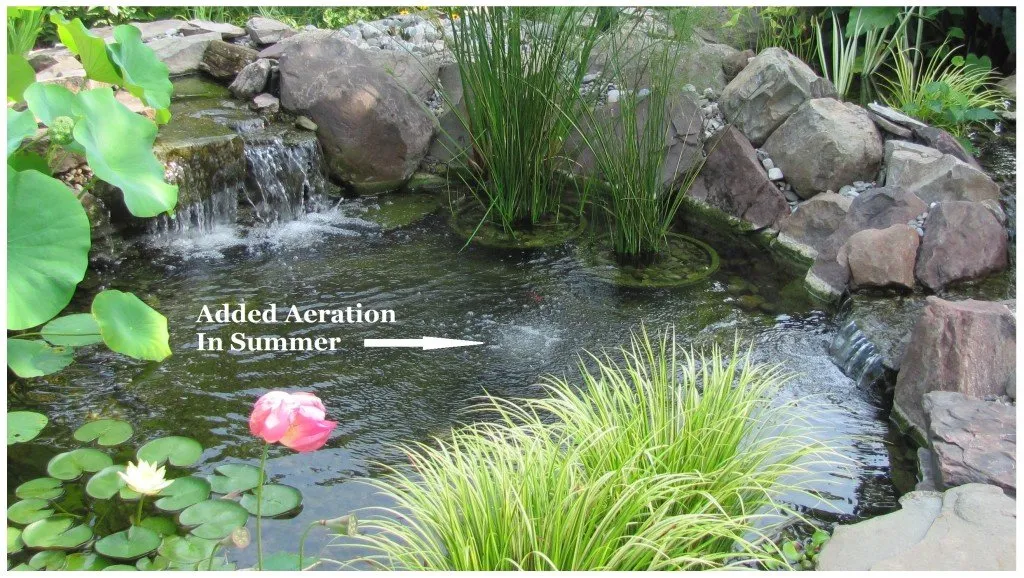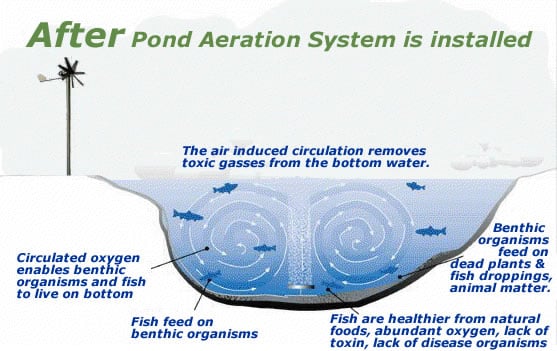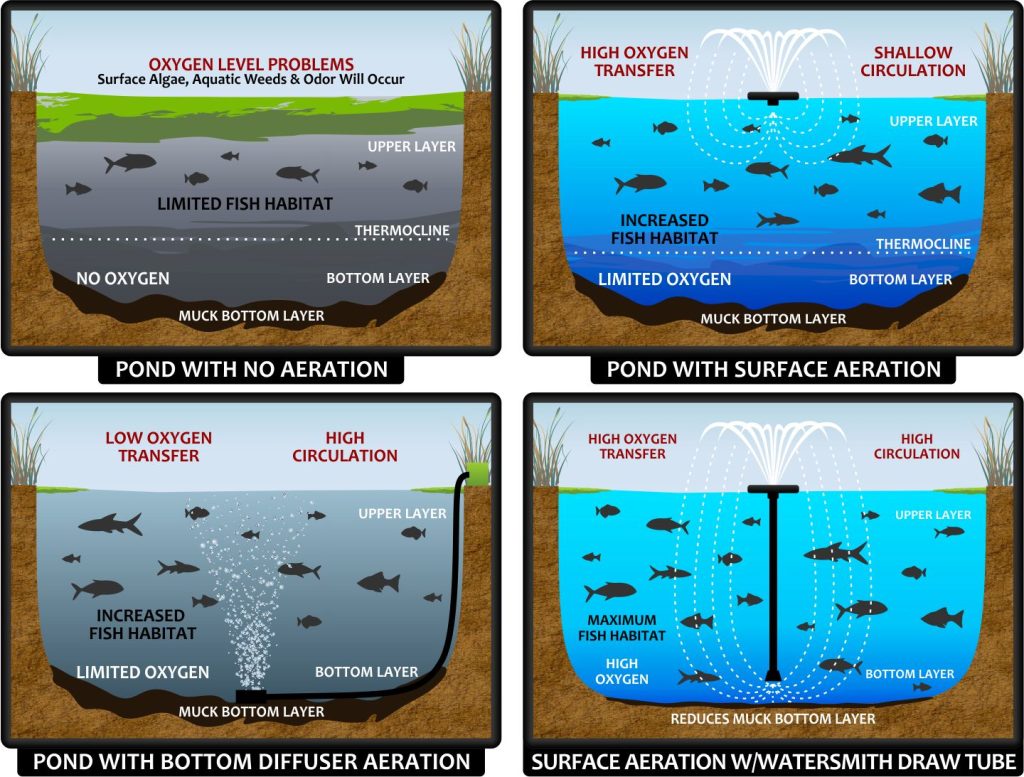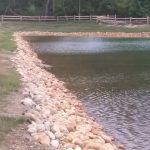To aerate a pond, install a pond aerator or fountain that circulates water and increases oxygen levels. This helps maintain a healthy ecosystem and prevents issues like algae growth and fish kills.
Intro: Maintaining proper oxygen levels in a pond is crucial for its overall health and vitality. Aeration plays a key role in achieving this by increasing oxygen circulation throughout the water. By doing so, it keeps the ecosystem balanced and prevents the occurrence of common problems such as algae outbreaks and fish fatalities.
We will explore the process of pond aeration and provide simple steps to effectively aerate your pond for optimal results. Whether you have a small garden pond or a large water feature, understanding how to aerate it properly will ensure a thriving and beautiful aquatic environment for years to come.

Credit: premierpond.com
Benefits Of Pond Aeration
Aerating a pond is a crucial step in maintaining a healthy aquatic ecosystem. By introducing oxygen into the water, pond aeration offers numerous benefits that bolster water quality and support the well-being of fish and other aquatic life. Understanding the benefits of pond aeration is essential for anyone looking to maintain a thriving pond environment.
Improving Water Quality
Aeration plays a vital role in improving water quality by promoting oxygen circulation and reducing the accumulation of stagnant water. By enhancing the oxygen levels in the pond, aeration helps prevent the proliferation of anaerobic bacteria, which can lead to the buildup of harmful gases and the production of foul odors. Additionally, a well-aerated pond can support beneficial bacteria that break down organic matter and nutrients, contributing to clearer and healthier water.
Enhancing Fish Health
Proper pond aeration enhances fish health by providing the oxygen required for their survival. Adequate oxygen levels are essential for fish respiration and overall well-being. Furthermore, by circulating the water and reducing stratification, aeration creates a more uniform temperature throughout the pond, ensuring a more hospitable environment for fish and other aquatic organisms.
Types Of Pond Aerators
Pond aerators are essential for maintaining a healthy aquatic environment. There are two main types of pond aerators: surface aerators and subsurface aerators. Each type serves a distinct purpose in delivering oxygen to the pond and promoting the well-being of aquatic life.
Surface Aerators
Surface aerators work by agitating the surface of the water and creating oxygen transfer. This type of aerator is typically mounted on the shore of the pond and uses a pump to draw in water and propel it into the air, where it is oxygenated and then returned to the pond. The churning action also helps to prevent algae growth and improve water circulation.
Subsurface Aerators
Subsurface aerators, also known as diffused aerators, release compressed air from the bottom of the pond. This creates bubbles that rise to the surface, carrying oxygen from the atmosphere down into the water. These aerators are beneficial for deeper ponds and can help reduce stratification by circulating the water column.
Factors To Consider
Aerating a pond is a crucial step in maintaining a healthy aquatic environment. It helps to increase oxygen levels and prevent the buildup of harmful gases, keeping the fish and other organisms thriving. Before you begin the aeration process, there are several factors to consider to ensure optimal results. Let’s take a closer look at these factors:
Size Of The Pond
The size of your pond plays a vital role in determining the type and number of aerators required. A larger pond will need more powerful aerators to circulate the water effectively. On the other hand, a smaller pond might only require a single aerator to achieve the desired oxygen levels. Consider the surface area and volume of your pond when choosing the appropriate aerator.
Depth Of The Pond
The depth of your pond is equally important when selecting the right aerator. Different ponds have varying depths, and this affects how the water circulates. Shallow ponds may require additional floating aerators, while deeper ponds might benefit from bottom-mounted diffusers. Understanding the depth of your pond ensures that you choose the aerator that can effectively reach all areas of the water column.
Climate And Weather Conditions
The climate and weather conditions in your area should not be overlooked. The temperature, precipitation, and wind patterns can impact the oxygen levels in the pond. For example, if you live in a hot and humid region, the oxygen levels in your pond may decrease, and as a result, you may need a more powerful aerator. Additionally, extreme weather conditions like heavy rain or prolonged drought can further affect the water quality. Keep these factors in mind when selecting the appropriate aeration system for your pond.

Credit: www.youtube.com
Aeration Techniques
Aeration techniques play a crucial role in maintaining a healthy pond environment. By ensuring proper aeration, you can promote oxygen levels and enhance overall water quality. Here, we will discuss two main methods of aeration: Continuous Aeration and Intermittent Aeration.
Continuous Aeration
Continuous Aeration involves running an aeration system 24/7 to provide consistent oxygen levels. This method is ideal for ponds with high oxygen demands, such as heavily stocked fish ponds or ponds with organic buildup.
- Install a subsurface aeration system to release bubbles at the pond bottom.
- Position diffusers strategically to ensure uniform oxygen distribution.
- Regularly monitor oxygen levels to adjust aeration settings accordingly.
Intermittent Aeration
Intermittent Aeration operates in cycles, supplying oxygen at specific intervals. This method is suitable for ponds where oxygen demands fluctuate throughout the day.
- Program the aeration system to run in short intervals at set times.
- Consider using a timer to automate the on/off cycles for convenience.
- Adjust the aeration schedule based on seasonal oxygen needs and pond activity.
Choose the aeration technique that best suits your pond’s requirements, whether it be continuous aeration for constant oxygen supply or intermittent aeration for varying oxygen demands.
Installation And Maintenance
When it comes to ensuring the health and vitality of your pond, proper installation and regular maintenance of pond aerators is crucial. Effective aeration not only helps improve water quality but also fosters a thriving ecosystem for aquatic life. In this article, we will delve into the essential aspects of installation and maintenance to ensure your pond receives optimal aeration.
Proper Placement Of Aerators
The placement of pond aerators directly impacts their efficiency. Aerators should be strategically placed to promote consistent circulation and oxygenation throughout the entire pond. Ensure that the aerator is positioned in an area with minimal obstructions to facilitate maximum airflow and water movement.
Regular Cleaning And Inspection
Regular cleaning and inspection are vital for maintaining the effectiveness of pond aerators. Perform routine checks to ensure there are no blockages or debris hindering the aerator’s functionality. Cleaning the aerator components, such as the diffusers and filters, will help prevent clogging and ensure optimal performance.

Credit: www.pondperfection.com
Troubleshooting Common Issues
Even with regular maintenance, ponds can face common issues that affect aeration. Understanding and resolving these issues is crucial to maintaining a healthy pond ecosystem. Below, we will explore two common issues and provide solutions for troubleshooting them.
Low Oxygen Levels
Low oxygen levels can be detrimental to the health of aquatic life in the pond. This problem is often caused by factors such as excessive algae growth, high temperatures, or overstocking of fish. To address low oxygen levels, consider the following:
- Increasing aeration: Invest in additional aerators or increase the operating time of existing aerators to boost oxygen levels.
- Reducing nutrient levels: Implement measures to control algae growth, such as adding aquatic plants or using algaecides to maintain a balanced ecosystem.
- Monitoring stocking levels: Ensure that the pond is not overcrowded with fish, as this can significantly impact oxygen levels.
Clogging Of Aerators
A common issue that affects aerators is clogging, which can diminish their effectiveness in aerating the pond. If you notice reduced airflow or water circulation, you may need to address clogging. Here’s how to troubleshoot this issue:
- Regular cleaning: Schedule routine maintenance to clean aerator components and remove any debris or buildup that may impede airflow.
- Use protective measures: Consider using screen guards or protective covers to prevent debris such as leaves, twigs, and algae from entering the aerator inlets.
- Check air filters: Ensure that air filters are clean and free from blockages, as clogged filters can hinder the performance of the aerator.
Conclusion
To sum up, regular pond aeration is crucial for maintaining a healthy ecosystem. By following these simple steps, you can improve water quality and promote the well-being of your aquatic life. Remember, a well-aerated pond is a happy pond! Keep your pond thriving with proper aeration techniques.





